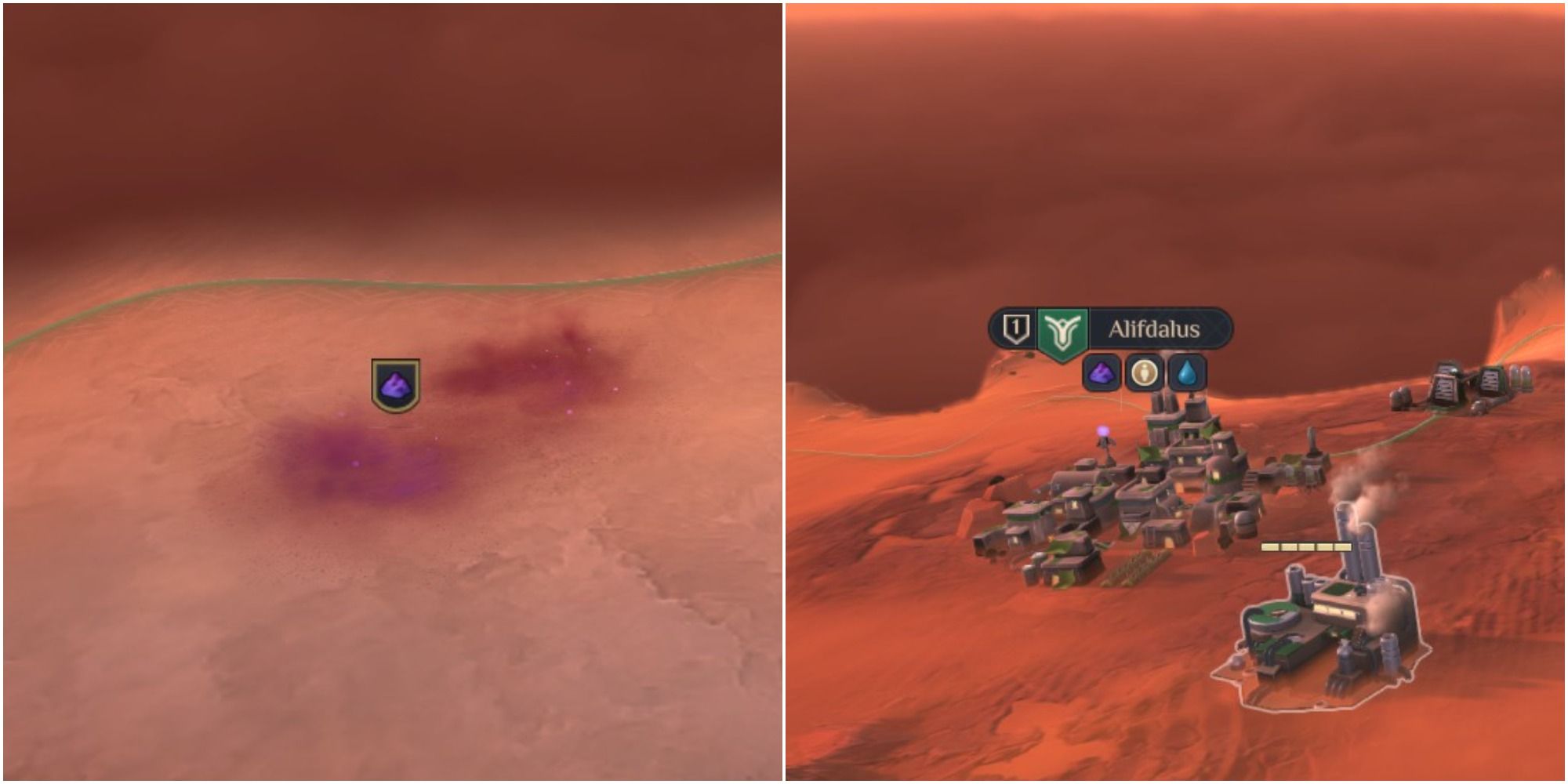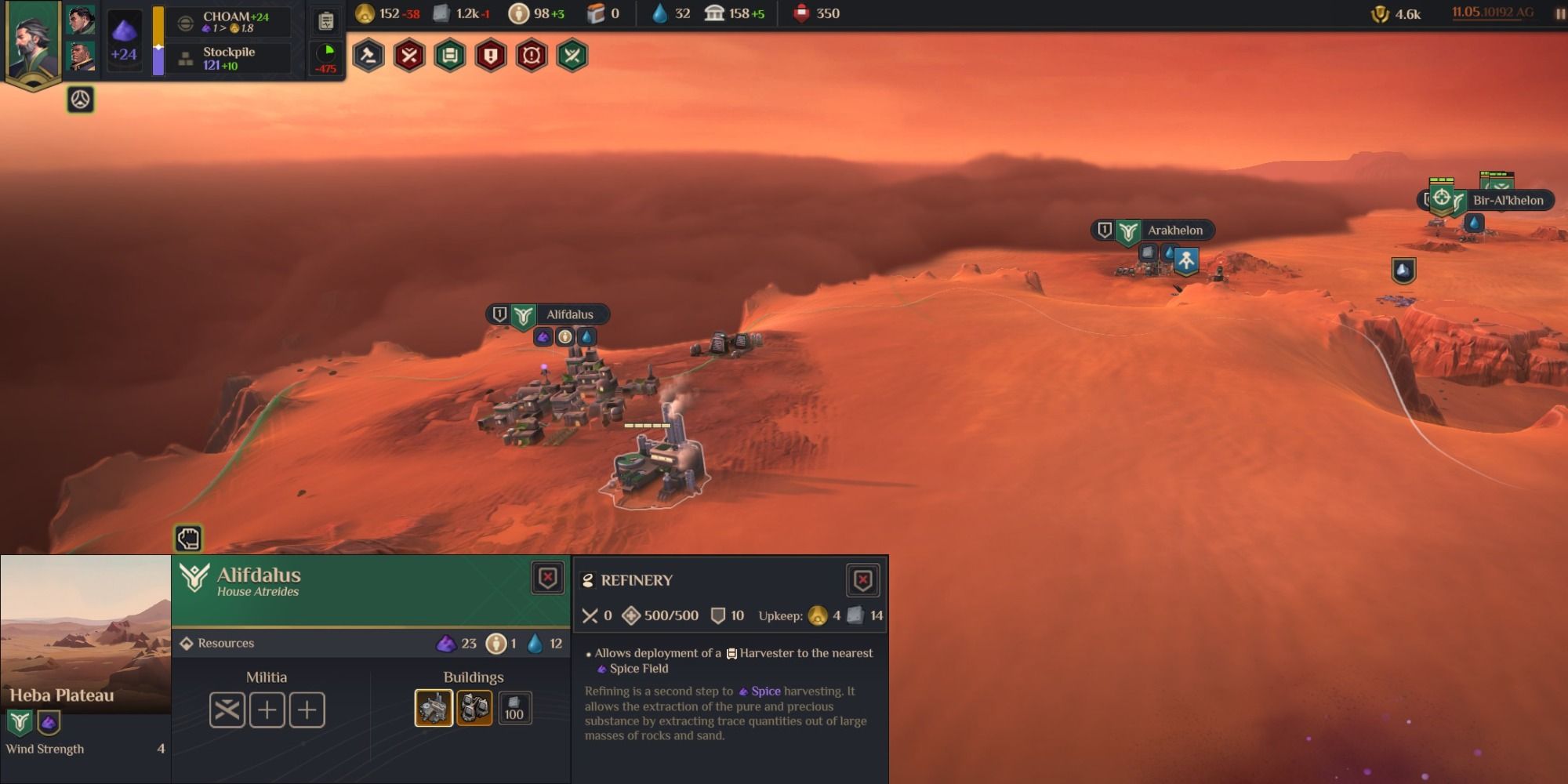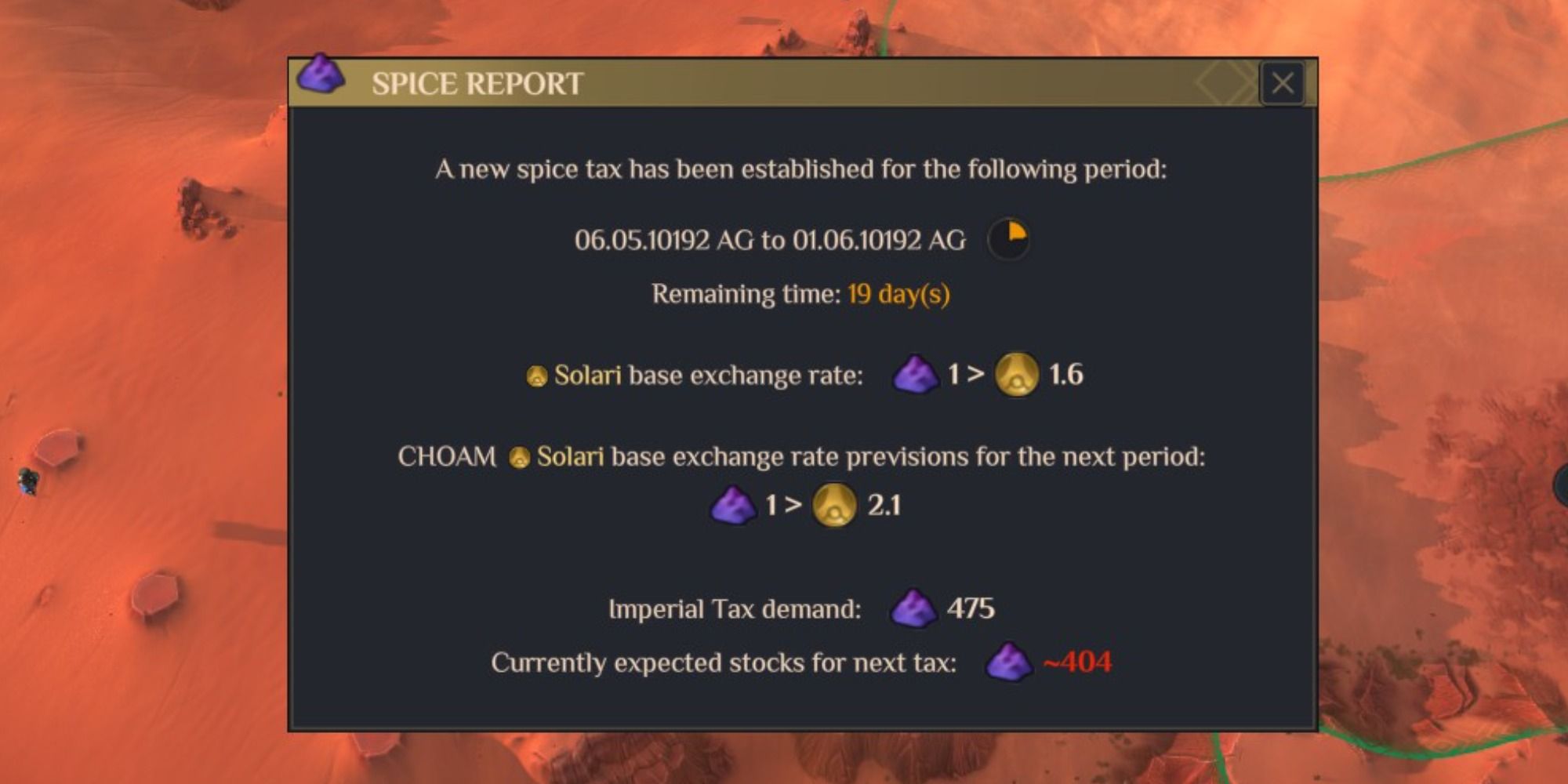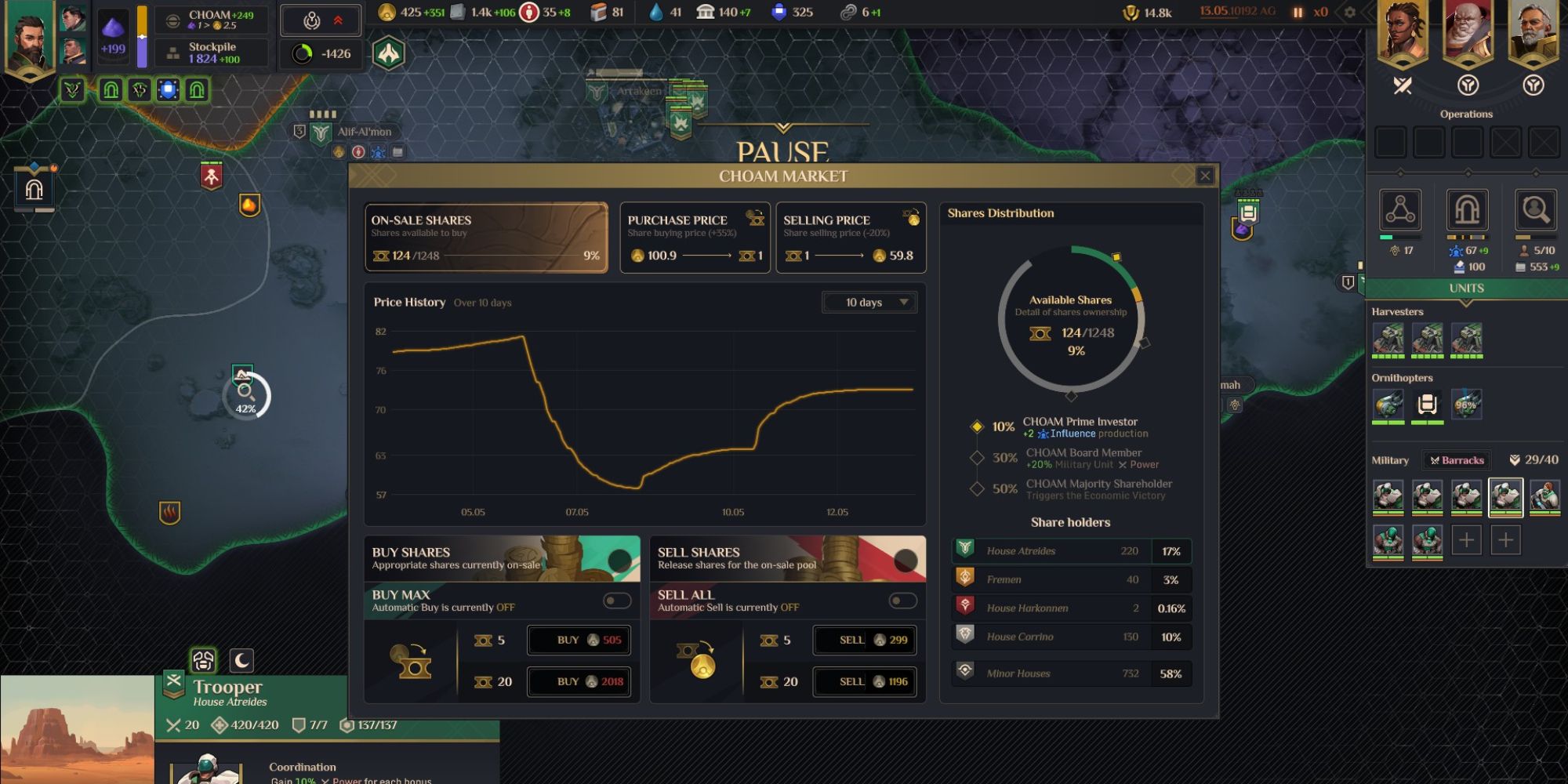As you might expect from a 4X strategy game based on Frank Herbert's Dune, Spice is a very important resource that you'll have to locate, and manage. Dealing with Spice and the SpiceMarket is something you'll have to do throughout the entire game, and it's a mechanic ripe for exploitation.
The Spice Market is likely going to be your primary source of income, but it's something that fluctuates a lot. In addition, you have the ever-changing Imperial Tax to deal with, so it's not like Spice is something you can ignore once you've got a few sources.
Updated on September 14, 2023: Dune: Spice Wars has emerged from early access. We've updated this guide to include the CHOAM Shares mechanic and Economic Victory.
How To Get Spice
Obtaining Spice is a simple matter of exploring the surface of Arrakis for purple deposits of the resource. You can identify them by the icon that looks like a mound of purple dust.
To actually harvest this spice, you'll need to take over a village in the same region and construct a Refinery in it. Refineries have some Solari and Plascrete upkeep costs, but the Spice you'll get from the Harvesters produced by the Refinery will outweigh the costs.
Harvesters will occaionally be threatened by Arrakis' enormous Sandworms. You can set them to be automatically recalled at the first sign of a worm's presence, but they have to be manually redeployed and their production is reduced by five percent while their auto-recall is turned on. It's best to just recall them manually - the Spice must flow, after all.
You can improve your Harvesters by adding Crew to them. To do this, click the Add Crew button on the upper-right corner of the menu when you have a Harvester selected. Hiring a Crew member has a one-time cost of 40 Manpower, but does not have any upkeep costs. The middle branch of the Economy tech tree adds to your Harvesters' Crew capacity.
It's also important to note that the Fremen have a slightly different process for harvesting Spice than the other factions.
The Spice Market
Once you have a source of Spice being worked by a Harvester, you'll start to gain spice constantly. This is tracked on the upper-left section of the screen and there are a few things to make a note of. The large number under the Spice icon is your total spice production - the fruits of your Harvesters' labor. Next to that are two boxes, one for CHOAM, and one for your Stockpile.
- The CHOAM is the Combine Honnete Over Advancer Mercantiles, which acts as the spice market in this game. The current rate for Spice is shown at the top-left corner of the screen.
-
Your stockpile, on the other hand, is simply a resource that you pump spice into. It serves two purposes:
- Whenever the deadline for spice taxes is up, the Imperial Tax demand will be taken from your stockpile automatically. If you do not have enough spice in your stockpile, you will incur penalties.
- You can use your stockpile of spice in trades, which is useful for bargaining with spice-poor factions.
You can change the proportion of spice being sold to spice being stockpiled with the slider on the left, which moves in 10 percent increments. For example, if you decide to sell 20 percent of your spice to the CHOAM, it means you're automatically stockpiling 80 percent of your spice. It is possible to sell or stockpile 100 percent if you so wish.
The exchange rate for spice to Solari will change every month, as will the Imperial Tax demand. The key to playing the spice market is to stockpile as much spice as you can when the market is weak, and then sell it when the market is strong. This way, you'll have a nice stockpile of spice for months when you'd rather sell the majority of it.
Certain technologies and buffs can increase your sale price for Spice. The Great Houses (except House Corrino) also get better Spice prices as long as they pay their taxes on time.
If you click the Spice Report button above the countdown to the Imperial Tax deadline, you can read useful information about the current tax cycle and get a preview of what the next month's exchange rate will be. Most importantly, though, is the "Currently expected stocks for next tax" calculation which allows you to see if you will have enough spice stockpiled for the end of the current tax cycle. If you don't, it's a good idea to move the slider on the left more in favor of stockpiling spice.
This calculation does not include any possible disruptions to your spice income, such as invasions from rival factions or your Harvesters being threatened by sandworms. Always take these numbers with a grain of salt.
If you are in a month with very high spice prices and you find your stockpile lacking, you may want to find alternative methods to increase your stockpile to make the Imperial Tax deadline. These include:
- Trading with friendly factions for some of their spice stockpiles.
- Some points of interest have a resolution option that grants you spice, usually a few hundred. Save one or two of these for moments like these.
In conclusion, keeping a close eye on the spice market and adjusting accordingly is one of the main strategic features of Dune: Spice Wars and careful exploitation of the system will lead to great profit.
CHOAM Shares And Economic Victory
Shortly after the first tax cycle, the CHOAM stock market will open. Players can buy and sell shares of CHOAM from the available pool in batches of five or twenty. The price of shares fluctuates automatically as they are bought or sold, and you can see the current market trend at a glance displayed on the market button in the top-left.
At the start of the game, all CHOAM Shares are owned by the Minor Houses. Each time Spice Tax is collected, the Minor Houses will release a small number of shares for sale. Shares sold by a player are also returned to the pool, and can be bought by anyone.
Once the Minor Houses release shares, they'll never buy them back; this means that over the course of the game ownership of CHOAM will slowly transfer to the players that invest.
Owning a significant percentage of the total CHOAM Shares can unlock special bonuses:
|
CHOAM Ownership |
Bonus |
|---|---|
|
Ten Percent |
Prime Investor: The player generates two additional Influence per turn. |
|
Thirty Percent |
Board Member: The player's military units deal twenty percent more damage in combat. |
|
Fifty Percent |
Majority Shareholder: The player immediately wins the game via an Economic Victory. |
Shares that are not currently owned by anyone (i.e., are available for purchase) do not count toward the total number of shares when calculating this percentage. This means that purchasing shares can knock another player back below the threshold for a bonus! It also means that you'll need to continuously buy shares as they're made available by the Minor Houses to keep your current tier.
It's very important to note that CHOAM Shares do not generate income. You can sell them when their value is high for a quick injection of cash, but otherwise the only reason to own them is to unlock their bonuses and compete for Economic Victory.





